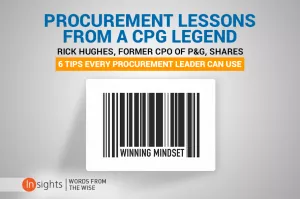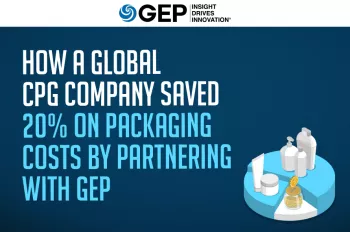One of my learnings after more than 30 years in procurement at P&G is that procurement roles in different industries face similar challenges and opportunities. We all struggle with budget, talent, market dynamics, economic and political shifts. All procurement leaders want to be the best they can be, and need a solid understanding of procurement skills to be able to lead through the stormy waters that we all experience.
At P&G, I worked and led through six currency crises, multiple supply assurance “black swans,” only one Great Recession (thankfully) and many significant weather events, explosions, supplier bankruptcies, business sales, acquisitions, and loss of top talent. These situations occur in any and all procurement roles, but there are some unique considerations for procurement professionals in the Consumer Packaged Goods (CPG) industry compared with other industries. Here are six key procurement lessons from the CPG industry that are equally relevant for procurement professionals across all industries.
Understand your end consumers
CPG companies are directly connected to consumers. This helps in understanding how the average person thinks and behaves in the market place. Social media has helped bring massive consumer insights to CPG firms, and smart firms use these insights each day to develop and improve product offerings. Suppliers often ask us what was happening in our business to help them understand the direction of economies and consumer sentiment. This direct connection to consumers and buyers helps sourcing professionals understand the pulse of the business, gain insights into new trends, and realize the direction of the economy in each geography. Sourcing and procurement executives must be cognizant of the market dynamics, particularly as consumers drive and shape the economic future of so many countries, communities and industries.
Invest in developing category expertise
Direct and indirect procurement are vastly different, but the fundamental skills are essentially the same — negotiation, inquiry, business and market intelligence. However, buyer behavior and expectations are quite different – manufacturing sites know they need to rely on purchasing to source goods for the plant site; the legal division or finance discipline not so much. Buyers whose core competency is what we are buying (like legal services for the legal division, or marketing agencies for brand management) are much more intellectually invested than simply requisitioning materials for product production. This makes it even more challenging but not as interesting as learning how enzymes work and are made, or watching blowmolders turn out thousands of bottles each day. These differences keep the work interesting, and require sourcing professionals to understand the technology, industries and markets of what they sourcing. Often it takes time to penetrate the market dynamics of more complex markets (like media) or unique knowledge (like in legal or financial services) and sourcing professionals need to invest the time to learn, as well as to understand the nuances of each direct and indirect category.
Utilize multiple sourcing levers and strategies
There are a large number of direct and indirect categories, large and small spends. From chemicals, packaging, contract manufacturing, perfume and flavor ingredients, marketing and advertising services, capital equipment, design services, consumer market knowledge (CMK) services and reach across multiple different industries. The variety makes the role even more challenging and exciting. This doesn’t suggest that other industries or sectors are not interesting, but that those who work in CPG can deal with myriad sourcing challenges and need to leverage multiple levers and strategies to drive value. Employees who have worked in CPG firms likely have broad experience in a variety of categories and market dynamics. This can be leveraged by procurement leaders and third parties dealing with CPG firms.
Focus on improving supplier diversity
B2B enterprises are often relatively disconnected from consumers, and many suppliers don’t understand the push for supplier diversity. So the spend is usually not reflected in the consumer base. In the U.S., the demography of our population is changing dramatically, and will continue to do so. The P&G supply base is designed to reflect and leverage these changes by ensuring a diverse supply base, not just based on ethnicity, but also location, talent, capability, size and scope. Since consumers are diverse, suppliers must be diverse as well. This is also now a growing opportunity in other countries, such as China, India, the UK, Canada, among others. This diversity in supply base drives improved competition, increased innovation, and unique value propositions. Sourcing professionals must constantly seek diversity in suppliers to mitigate risk and ensure long-term sustainable supply sources.
Stay on top of market trends
The retail trade is important for CPG companies. The vast majority of CPG business takes place in physical stores around the world. The store design is different in different geographies (large format in the U.S. and parts of Western Europe; high frequency store formats in developing geographies). This is changing with Amazon and Alibaba, and one of the complexities and opportunities is to sell concurrently through traditional retail and online retail. Procurement organizations often need to have different capabilities in logistics, packaging, marketing and media for different trade channels. Procuring for a high-frequency market — where traditional media is rare — requires different media sourcing strategies, like billboards, shelf talkers, and radio. Retail trends and changes directly impact sourcing strategies, and sourcing professionals must stay on top of the trends in retail to know what, when and how to source. Take, for example, frustration-free packaging versus traditional big-box store packaging. Sourcing for Alibaba or Amazon is much different than WalMart or Carrefour, and requires knowledge of how retail trends are changing to ensure the right value levers are employed effectively.
Reduce the complexity in procurement operations
The complexity of CPG business can be perplexing. P&G had more than 350,000 different specifications on materials and services purchased. The company had over 200 brands, 85,000 suppliers around the world, from whom we actively sourced and another 175,000 suppliers from whom we had purchased in the prior two years. P&G was doing business in 180 countries, and had operations on the ground in 80 countries. We spent over $50 billion per year. The complexity in a company with this scope and scale can be quite overwhelming. Other CPG companies have similar complexity in their supply chains. Companies in other industries, such as automotive, communications, technology, have simplified their supply chains and product platforms, and CPG firms are trying to do likewise. Procurement service providers, such as GEP can help drive this by providing visibility on tail-spend, absorbing some or all of the tail-spend sourcing management, managing non-core spend categories, bringing technology solutions and added capabilities like accounts payable, supply market intelligence, and rigorous process metrics. This complexity offers the opportunity for sourcing professionals to streamline and simplify, to integrate supply networks, and to connect disparate partners in seamless supply communities. Productivity will be a megatrend for years to come, and reducing the complexity of procurement operations will serve procurement well in the eyes of their business clients and colleagues.
About the Author:
Rick Hughes is an industry giant, respected for his insight, candor, leadership skills and deep procurement expertise. Formerly CPO of Procter & Gamble (P&G), Rick has served in a variety of leadership roles in more than 31 years with P&G, where he developed and transformed the company’s purchasing team into a bestin-class model for Global 2000 and Fortune 500 enterprises worldwide, and one of the most benchmarked procurement organizations in history. Today, Rick works with GEP to advise Fortune 500 and Global 2000 clients worldwide on procurement transformation, organizational development, supply innovation, global risk management, and other strategic issues related to procurement and supply chain management.
Theme: Operations



